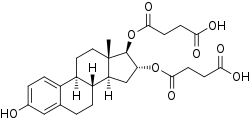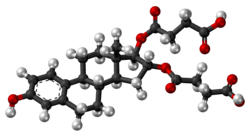Estriol succinate
Estriol succinate, sold under the brand name Synapause among others, is an estrogen medication which is used in the treatment of menopausal symptoms.[1] It is taken by mouth, in through the vagina, and by injection.[1][2][3]
 | |
 | |
| Clinical data | |
|---|---|
| Trade names | Synapause, others |
| Other names | Oestriol succinate; Estriol disuccinate; Estriol hemisuccinate; Estriol 16α,17β-di(hydrogen succinate) |
| Routes of administration | By mouth, vaginal[1] |
| Drug class | Estrogen; Estrogen ester |
| Identifiers | |
IUPAC name
| |
| CAS Number | |
| PubChem CID | |
| ChemSpider | |
| UNII | |
| KEGG | |
| ChEBI | |
| Chemical and physical data | |
| Formula | C26H32O9 |
| Molar mass | 488.533 g/mol g·mol−1 |
| 3D model (JSmol) | |
SMILES
| |
InChI
| |
Medical uses
Estriol succinate is used in menopausal hormone therapy in the treatment and prevention of menopausal symptoms such as hot flashes, vaginal atrophy, and osteoporosis.[1] Unlike other estrogens, depending on how it is used (i.e., how often it is taken and at what dosage), estriol succinate may not require concomitant therapy with a progestogen to prevent endometrial hyperplasia and endometrial cancer in women with intact uteruses.[1]
The clinical effects of estriol succinate in the treatment of menopausal symptoms have been characterized in a large 5-year clinical trial of 911 menopausal women.[4][5][6]
Side effects
Pharmacology
Estriol succinate is an estrogen ester, specifically, an ester of estriol, and acts as a prodrug of estriol in the body.[7][1] It is described as a weak estrogen in comparison to estradiol valerate.[1][8] Estriol succinate is used medically via oral and vaginal routes similarly.[1] In estriol succinate, two of the hydroxyl groups of estriol, those at the C16α and C17β positions, are esterified with succinic acid.[1] As such, when adjusted for differences in molecular weight, a dose of 2 mg estriol succinate is equivalent to 1.18 mg unconjugated estriol.[1] Unlike other estrogen esters, such as estradiol valerate, estriol succinate is hydrolyzed almost not at all in the intestinal mucosa when taken orally, and in relation to this, is absorbed more slowly than is estriol.[1] Consequently, oral estriol succinate is a longer-acting form of estriol than oral estriol.[9] Instead of in the gastrointestinal tract, oral estriol succinate is cleaved into estriol mainly in the liver.[1] After a single 8 mg oral dose of estriol succinate, maximum levels of circulating estriol of 40 pg/mL are attained within 12 hours, and this increases up to 80 pg/mL with continued daily administration.[1]
| Estrogen | Type | Class | ETD (mg/14 days) | EPD (mg/14 days) | EPD (mg/day) | MSD (mg/14 days) | MSD (mg/day) | TSD (mg/day) |
|---|---|---|---|---|---|---|---|---|
| Estradiol (non-micronized) | Bioidentical | Steroidal | ? | ≥120–300 | ? | ? | ? | ? |
| Estradiol (micronized) | Bioidentical | Steroidal | ? | 60–80 | 4.3 | 14–28 | 1.0–2.0 | >8 |
| Estradiol valerate | Bioidentical | Steroidal | 6–10 | 60–80 | 4.3 | 14–28 | 1.0–2.0 | >8 |
| Estradiol benzoate | Bioidentical | Steroidal | ? | 60–140 | 4.5 | ? | ? | ? |
| Estriol | Bioidentical | Steroidal | 20a | 120–150b | 10.0–10.7b | 28–84 | 1.0–6.0 | ? |
| Estriol succinate | Bioidentical | Steroidal | ? | 140–150b | 10.0–10.7b | 28–84 | 2.0–6.0 | ? |
| Conjugated estrogens | Natural | Steroidal | 5–12 | 60–80 | 4.3 | 8.4–17.5 | 0.625–1.25 | 7.5 |
| Ethinylestradiol | Synthetic | Steroidal | 0.2 | 1.0–2.0 | 0.071–0.11 | 0.28 | 0.02–0.04 | 0.1 |
| Mestranol | Synthetic | Steroidal | 0.3 | 1.5–3.0 | 0.11–0.13 | 0.3–0.5 | 0.025 | ? |
| Quinestrol | Synthetic | Steroidal | 0.3 | 2.0–4.0 | 0.14–0.29 | ? | 0.025–0.05 | ? |
| Methylestradiol | Synthetic | Steroidal | ? | 2.0 | ? | ? | ? | ? |
| Diethylstilbestrol | Synthetic | Nonsteroidal | 2.5 | 20–30 | 1.4–2.1 | ? | 0.5–2.0 | 3 |
| Diethylstilbestrol dipropionate | Synthetic | Nonsteroidal | ? | 15–30 | 1.1–1.4 | ? | ? | ? |
| Dienestrol | Synthetic | Nonsteroidal | ? | 30 | ? | ? | 0.5–4.0 | ? |
| Dienestrol diacetate | Synthetic | Nonsteroidal | 3–5 | 30–60 | 2.9–4.3 | ? | ? | ? |
| Hexestrol | Synthetic | Nonsteroidal | ? | 70–110 | ? | ? | ? | ? |
| Hexestrol diacetate | Synthetic | Nonsteroidal | ? | 45 | ? | ? | ? | ? |
| Chlorotrianisene | Synthetic | Nonsteroidal | ? | >100 | ? | ? | ? | ? |
| Methallenestril | Synthetic | Nonsteroidal | ? | 400 | ? | ? | ? | ? |
| Note: The OID of EE is 0.1 mg/day. Footnotes: a = Very variable, often higher. b = In divided doses, 3x/day; irregular and atypical proliferation. Sources: See template. | ||||||||
Chemistry
Estriol succinate, also known as estriol disuccinate or as estriol 16α,17β-di(hydrogen succinate), is a synthetic estrane steroid and a derivative of estriol.[7][10][11] It is specifically the C16α and C17β disuccinate ester of estriol.[7][10][11][1] The medication is provided both as estriol succinate and as estriol sodium succinate, the sodium salt.[7][10] Other marketed estriol esters besides estriol succinate include estriol acetate benzoate and estriol tripropionate, whereas estriol dihexanoate, estriol dipropionate, and estriol triacetate are estriol esters that were never marketed.[7][10] Quinestradol is an estriol ether and has also been marketed.[7][10] Polyestriol phosphate is an ester of estriol in the form of a polymer, and was previously marketed.[12][13][14][15]
History
Estriol succinate was introduced for medical use in 1966.[16]
Society and culture
Generic names
Estriol succinate is the generic name of the drug and its INN and BAN.[7][10][17][11][16] Other synonyms include oestriol succinate, estriol disuccinate, and estriol hemisuccinate.[7][10][17][11] When provided as the sodium salt, estriol succinate is known as estriol sodium succinate (BAN) or as oestriol sodium succinate.[7][10]
Brand names
Estriol succinate has been marketed under brand names including Blissel, Evalon, Gelistrol, Hemostyptanon, Orgastyptin, Ovestin, Sinapause, Styptanon, Synapsa, Synapasa, Synapausa, and Synapause, among others.[7][10][17][11] Estriol sodium succinate has been marketed specifically under the brand names Pausan and Styptanon.[7][10]
Research
Estriol succinate was under development for the treatment of multiple sclerosis in the United States and worldwide, and reached phase II clinical trials for this indication, but development was discontinued due to insufficient effectiveness.[18] It had the tentative brand name Trimesta.[18]
References
- Kuhl H (2005). "Pharmacology of estrogens and progestogens: influence of different routes of administration" (PDF). Climacteric. 8 Suppl 1: 3–63. doi:10.1080/13697130500148875. PMID 16112947.
- R. S. Satoskar; S. D. Bhandarkar &nirmala N. Rege (1973). Pharmacology and Pharmacotherapeutics. Popular Prakashan. pp. 934–. ISBN 978-81-7991-527-1.
- Axel Kleemann; Jürgen Engel (2001). Pharmaceutical substances: syntheses, patents, applications. Thieme. p. 786. ISBN 978-3-13-558404-1.
- Lauritzen C (November 1987). "Results of a 5 years prospective study of estriol succinate treatment in patients with climacteric complaints". Horm. Metab. Res. 19 (11): 579–84. doi:10.1055/s-2007-1011886. PMID 3428874.
- Ali ES, Mangold C, Peiris AN (September 2017). "Estriol: emerging clinical benefits". Menopause. 24 (9): 1081–1085. doi:10.1097/GME.0000000000000855. PMID 28375935.
- Lommen, Erin; Mead, Jay H (2013). "Estriol; the 'Good' Estrogen Advances and Updates in its Clinical Uses". Journal of Restorative Medicine. 2 (1): 45–52. doi:10.14200/jrm.2013.2.0103. ISSN 2165-7971.
- J. Elks (14 November 2014). The Dictionary of Drugs: Chemical Data: Chemical Data, Structures and Bibliographies. Springer. p. 899. ISBN 978-1-4757-2085-3.
- Winnifred Berg Cutler; Celso-Ramón García (1984). The medical management of menopause and premenopause: their endocrinologic basis. Lippincott Williams & Wilkins. p. 31. ISBN 978-0-397-50631-6.
- Clark JH, Markaverich BM (1983). "The agonistic and antagonistic effects of short acting estrogens: a review". Pharmacol. Ther. 21 (3): 429–53. doi:10.1016/0163-7258(83)90063-3. PMID 6356176.
- Index Nominum 2000: International Drug Directory. Taylor & Francis. January 2000. pp. 407–. ISBN 978-3-88763-075-1.
- https://www.drugs.com/international/estriol.html
- Lauritzen C, Velibese S (September 1961). "Clinical investigations of a long-acting oestriol (polyoestriol phosphate)". Acta Endocrinol. 38 (1): 73–87. doi:10.1530/acta.0.0380073. PMID 13759555.
- Bachmann FF (January 1971). "Behandlung klimakterisher Beschwerden mit Polyöstriolphosphat" [Treatment of menopausal complaints with polyoestriol-phosphate. Experiences with Gynäsan injections]. Munch Med Wochenschr (in German). 113 (5): 166–9. PMID 5107471.
- A. Labhart (6 December 2012). Clinical Endocrinology: Theory and Practice. Springer Science & Business Media. pp. 548, 551. ISBN 978-3-642-96158-8.
The polymer of estradiol or estriol and phosphoric acid has an excellent depot action when given intramuscularly (polyestriol phosphate or polyestradiol phosphate) (Table 16). Phosphoric acid combines with the estrogen molecule at C3 and C17 to form a macromolecule. The compound is stored in the liver and spleen where the estrogen is steadily released by splitting off of the phosphate portion due to the action of alkaline phosphatase. [...] Conjugated estrogens and polyestriol and estradiol phosphate can also be given intravenously in an aqueous solution. Intravenous administration of ovarian hormones offers no advantages, however, and therefore has no practical significance. [...] The following duarations of action have been obtained with a single administration (WlED, 1954; LAURITZEN, 1968): [...] 50 mg polyestradiol phosphate ~ 1 month; 50 mg polyestriol phosphate ~ 1 month; 80 mg polyestriol phosphate ~ 2 months.
- S. Campbell (6 December 2012). The Management of the Menopause & Post-Menopausal Years: The Proceedings of the International Symposium held in London 24–26 November 1975 Arranged by the Institute of Obstetrics and Gynaecology, The University of London. Springer Science & Business Media. pp. 395–. ISBN 978-94-011-6165-7.
In the Federal Republic of Germany between 10 and 20% of all climacteric women are on estrogen treatment. We have the following oral estrogens for a treatment. (t) Conjugated estrogens, (2) estradiol valerate, (3) ethinyl-estradiol and its cyclopentyl-enol ether, (4) stilbestrol, (5) ethinyl-estradiol-methyltestosterone, (6) estriol and estriol succinate, most of them as coated tablets. Several long acting injectable preparations are available: several esters of combined estradiol-testosterone, one of estradiol-dehydroepiandrosterone enanthate and a prolonged polyestriol phosphate are also available. Lastly, depot injections of estradiol- and stilbestrol-esters are on the market.
- William Andrew Publishing (22 October 2013). Pharmaceutical Manufacturing Encyclopedia, 3rd Edition. Elsevier. pp. 1481–. ISBN 978-0-8155-1856-3.
- I.K. Morton; Judith M. Hall (6 December 2012). Concise Dictionary of Pharmacological Agents: Properties and Synonyms. Springer Science & Business Media. pp. 114–. ISBN 978-94-011-4439-1.
- https://adisinsight.springer.com/drugs/800026520